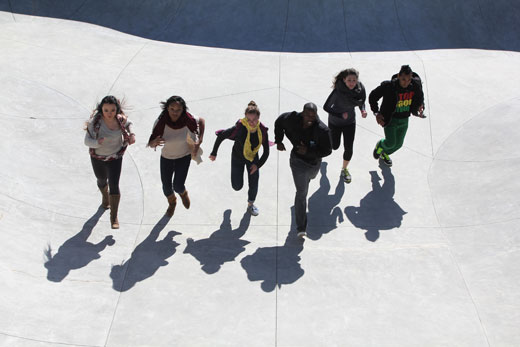Six Emory Dance Program students venture into the world of choreography, many for the first time, in the Emory Dance Company Spring Concert, "Tabula Rasa," April 26-28 in the Dance Studio of the Schwartz Center for Performing Arts. "Tabula Rasa" presents a varied collection of dance forms, touching upon hip-hop, jazz, as well as contemporary dance.
The 2012-2013 Emory Dance Company season celebrates the 10th anniversary of the Schwartz Center and in this final concert of the season, the students pay tribute to 10 years of performing excellence as well as the beginning of another decade upon a "tabula rasa," or "blank slate."
For the student choreographers, the concert provides an opportunity to further develop as artists and collaborators. "What I've loved most about choreographing is how collaborative it can be," explains Emory College student Lauren Kaplan. "A piece starts with a choreographer's vision or intention, but it doesn't come to life until we, as a group, get into the studio to make it happen."
The dancers in second-time choreographer Kaplan's piece may constitute a group, but their unique roles and personalities shine through as their movements change, develop and merge. With full-bodied and swift choreography, the dancers swallow the space as they envelop the audience in the world the piece creates. The driving force of Kaplan's process is the multitude of ways bodies adopt movement.
Kayla Davis, an Emory College senior and first-time choreographer, has been dancing with Emory Dance Company for her entire four years at Emory. In her piece, Davis explores moments of desperation and the tactics human beings use to work through trying times.
Emily Hammond's piece is a response to the question frequently asked by audience members following a modern dance concert: "What was that about?" Through her choreography, Hammond encourages the audience to not take their role too seriously and to open their minds to an appreciation of the movement itself as well as its perceived nonsense.
Heidi Liu makes her choreographic debut with an exploration of the different layers of personality. These layers are uncovered onstage through experiments with alienation and intimacy, revealing the evolution of human interaction as relationships deepen.
Andre Lumpkin has turned his first experience as a choreographer into a journey of self-discovery. His piece is influenced by personal experiences and Lumpkin's own diverse collection of movement vocabulary.
Julio Ulises Medina's piece is driven by a desire to find a place for hip-hop dance vernacular on the contemporary concert stage. His work considers the current financial narrative of hip-hop music and what happens to a cultural community when its main goal is economic advancement instead of unity.

